by Elizabeth Cunningham
Mabel Dodge Luhan & Company: American Moderns and the West opened at the Albuquerque Museum of Art and History this past October. Each venue of a travelling exhibition differs in installation and interpretation. I interviewed museum curator Andrew Connors about his vision. What follows are photos and the story of the Albuquerque show.

Panorama of Albuquerque introduction to the Mabel Dodge Luhan & Company exhibition with keystone painting by Dasburg and Taos artists section. Courtesy of Juniper Manley
Andrew appreciated the exhibition’s egalitarian inclusiveness. Mabel & Company explained New Mexico art from a number of different cultural perspectives. 20th-century modernists hung next to Pueblo Indian easel painters and Hispanic santeros (carvers and painters of saints). This fresh take on New Mexico art thrilled Andrew. He chose modernist Andrew Dasburg’s Taos Houses as the show’s keystone. “This exhibition explains why we can look at this painting as a New Mexico painting.”
The installation opens with the more familiar paintings of the Taos Society of Artists juxtaposed against the art of modernists. It continues with art works that influenced Mabel’s early life in Buffalo and in Florence. Her New York and Taos art patronage years resound with modernist paintings, sculpture, and photographs. Many of these artists – Marsden Hartley, Georgia O’Keeffe, John Marin, Ansel Adams, and others – are part of the American art canon. So is their work created in northern New Mexico.
What further sets Mabel & Company apart is the inclusion of what she called the “Sister Arts”: literature, dance, music, and theater. The exhibition also includes books and articles written by such Mabel guests as D. H. Lawrence, Mary Austin, Willa Cather and Frank Waters. It also features creations by dancer and choreographer Martha Graham, and composers Leopold Stokowski and Carlos Chavez. The setting at Mabel’s allowed cross-pollination between these creatives. Contact with Pueblo easel painters like Awa Tsireh and Ma-Pe-Wi as well as 18th and 19th-century Hispanic santeros such as Molleno and José Rafael Aragon provided further cultural exchange, grounded in the artistic traditions of northern New Mexico.
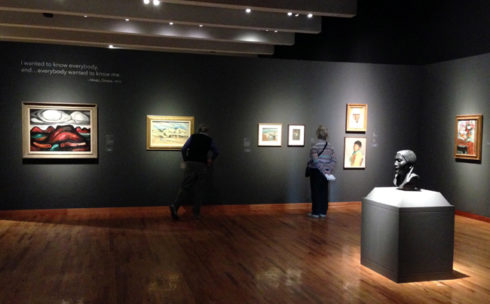
Albuquerque Museum installation shot showing paintings by Hartley and Dasburg, Mabel’s first Taos visitors in 1918, and bronze bust of Pedro Mirabal by Muurice Sterne. Courtesy of Andrew Connors
Since exhibitions aim to educate, I asked Andrew about public response. He reported a “very enthusiastic audience.” Viewers responded to the beauty of the objects. They enjoyed the telling of New Mexico history from a fresh perspective. Knowing about Andrew’s familiarity with New Mexico arts, I asked him if anything surprised him. He had expected great historical content from Mabel & Company co-curators MaLin Wilson-Powell and Lois Rudnick. However, he hadn’t anticipated such high quality art. “There are so many masterpieces.”
Part of the museum’s educational outreach included a five-minute video interview [see below] of Lois and MaLin. Their comments and the images shown give a great “live” overview of the exhibition. (For the record, over half of the objects in Mabel & Co. had never or not in recent history been exhibited.)
In summary, Andrew added “The exhibition reminds New Mexicans of treasures that are in our midst.” He thanked Lois and MaLin and the Harwood Museum of Art for creating and organizing Mabel & Company. “The Albuquerque Museum is proud to host this impressive show.”

Panorama of Albuquerque installation. Blanche portrait of Mabel (center), Brett paintings (right). Courtesy of Juniper Manley
Lois and MaLin uncovered some spectacular stories and coincidences that leave one wondering if Mabel herself was behind the scenes making things happen. That video inspired me to include the “behind-the-scenes” stories on three rediscovered art treasures. How they were discovered and the path the objects took to make it to this amazing exhibition is short of miraculous. It is a journey in and of itself.
On a trip to Buffalo in 2013, Lois made an appointment at the Albright-Knox Art Gallery to view a Jacques-Émile Blanche portrait of Mabel and her son. The portrait was painted in 1911. Measuring just under 8 feet by 6 feet, it was shown only once, at the Carnegie Museum of Art in 1924. After that show, Mabel donated the portrait to the Albright-Knox. It had been sitting in storage since then.
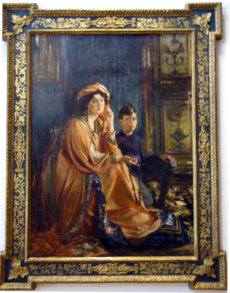
Photo of Jacques Emil Blanche’s Portrait of Mabel Dodge Luhan and Son showing ornate gilt frame. Permission Albright-Knox Art Gallery. See full painting citation below
“The conservator took me to the basement, and I was astonished by what I discovered, having only seen a small black and white photo of it,” said Lois. “The portrait was gargantuan, lavish, and luscious in terms of its depiction of Mabel in Renaissance style silk and velvet, seated on an elegant carved chair in the music room of her Medicean 15th century Villa Curonia, in Florence.”
The painting had darkened over time, the canvas was flaking, and the gilding on the massive ornate frame was corroded. When asked if it could be repaired, the conservator stated that it would cost several thousand dollars and was not affordable to the museum. A miracle happened not long after that conversation. The conservator wrote to Lois stating that a professor of conservation at Buffalo State University would take on the project for his MA students, at no cost. The Albright-Knox, Harwood, Albuquerque, and Burchfield museums all agreed to share the cost for the frame’s repair.
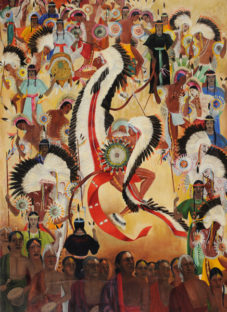
Dorothy Brett. Feather Dance, n.d. Oil on canvas, 50 x 36 inches. Collection Harry Ransom Center, University of Texas at Austin. Publicity photo for Mabel Dodge Luhan & Company, courtesy of the Harwood Museum of Art, Taos, NM
Feather Dance, a major painting by Dorothy Brett was “discovered” during MaLin’s research trip to the Harry Ransom Center at the University of Texas, Austin. In September 2014 she arranged to see an oil portrait of D.H. Lawrence by Kai Gotzsche. While she was there, MaLin noticed Brett’s Feather Dance a few racks away. The painting had not been exhibited since its acquisition in 1965.
“Since the Harwood already had excellent Brett paintings in their permanent collection, I wasn’t looking for more of her work,” said MaLin. “But Feather Dance was such a superlative example of Brett’s work, previously unexhibited and directly connected to Mabel – as well as an example of how inspiring the exuberance of Taos Pueblo ceremonial dances were to modern artists – I decided to request it for the exhibition.” For the Mabel & Company show, the painting had conservation work done and was reframed.
A bust of Pedro Mirabal, grandfather of Taos Pueblo artist and illustrator, Jonathan Warm Day Coming, sculpted by Mabel’s third husband Maurice Sterne, was rediscovered jointly by Lois and Jonathan, while independently researching the piece. The bust, originally owned by Mabel, was shown at the Maurice Sterne retrospective at New York’s Museum of Modern Art in 1933. (Sterne was the first American artist to be given a one-man retrospective at MOMA.) The piece was gifted to the Art Institute of Chicago in 1940 by Sam A. Lewisohn, a friend of Mabel’s.
The bronze sculpture had been sitting in a basement for over 75 years at the Art Institute of Chicago. A loan request sent by the Harwood was initially denied because it was “not in good condition.” Wondering how a bronze bust could not be in good condition, Lois contacted the curator who checked it out and realized it was just a matter of fixing the base. After this second inquiry, the Art Institute asked if the Harwood would like to acquire the piece. The sale was negotiated. The sculpture is now part of the Harwood’s permanent collection.
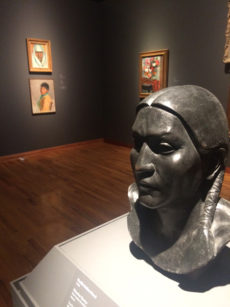
Albuquerque installation shot with bust of Pedro Mirabal by Maurice Sterne. Courtesy of Juniper Manley
Jonathan Warm Day Coming added his own back story. In childhood, he remembered driving with his family in their 1952 Ford flatbed around the Mabel Dodge Luhan complex on the way into Taos from Taos Pueblo. When they passed Mabel’s St. Teresa House, Jonathan’s aunt pointed out a wooden bust perched on top of a 4×4” beam. “There’s your Grandpa.”
During his time in Taos, Maurice Sterne had carved a wooden bust of Pedro Mirabal before casting it in bronze. Two years ago Jonathan started asking about the sculpture’s whereabouts. Nothing turned up. The wooden sculpture had disappeared.
Cognizant of Lois’s lead on the bronze at the Art Institute of Chicago (AIC), Harwood staffer Glory Ann Pennington helped Jonathan with his investigation. He subsequently wrote to the AIC, identifying the sculpture as his grandfather Pedro Mirabal. Jonathan provided background. “Beaded Shirt” (his grandfather’s name translated from the Tiwa language), a farmer and rancher at Taos Pueblo, had served in World War I. His tribe elected him war chief, a great honor. A member of the New Mexico Cattle Growers Association, he was among the first ranchers at the Pueblo. An artist himself, Pedro Mirabal modeled for Taos artists Nicolai Fechin and Joseph Imhof. (The Eiteljorg Museum in Indianapolis owns Fechin’s portrait.)
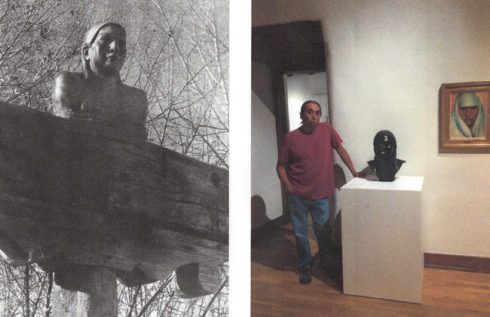
L: Wooden bust of Pedro Mirabal outside St. Teresa House. In Taos and Its Artists by Mabel Dodge Luhan. R: Jonathan Warm Day Coming beside Sterne’s bronze bust of Pedro Mirabal at the Harwood Museum of Art, Taos
When Jonathan learned that the Harwood Museum of Art had purchased Sterne’s bronze of his grandfather, he sighed with relief. The sculpture had come home.
From these accounts, it’s clear that what you see in the final installed exhibition is only part of the tale. Each object tells a story, one that well told can relay its journey. In this case connecting the past to and intertwining it with Mabel’s fascinating life. While the curator’s job is to tell a story through objects in an exhibition, the objects themselves often have a lot to say.
# # # # #
Video information: The impact of Mabel Dodge Luhan’s presence in Taos is alive and well and still being felt today. Take a look at this short video interview with curators MaLin Wilson-Powell and Dr. Lois Rudnick, then make sure you see the exhibition, Mabel Dodge Luhan & Co: American Moderns and the West before it closes on January 22, 2017. Created by the City of Albuquerque’s GOVTV.
Acknowledgments: Special appreciation to Harwood Director of Development Juniper Manley, who single-handedly raised funds for and played a key role in garnering support for and overseeing the organization of the Mabel Dodge Luhan & Company exhibition. With co-curators Lois Rudnick and MaLin Wilson-Powell, Juniper generated programming and press releases on the show. Publicity included commentary by Lois and MaLin on the three rediscovered art treasures, adapted for this blog piece.
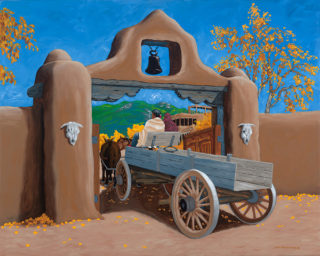
Gathering at Los Gallos, 2016 painting by Jonathan Warm Day Coming
NOTE: Festivities around the Mabel Dodge Luhan & Company show inspired Jonathan Warm Day Coming to paint Gathering at Los Gallos this past summer. The original sold immediately. However, the image is available as a card. Contact Jonathan Warm Day Coming.
Painting credit: Jacques-Emile Blanche (French, 1861-1942) Portrait of Mrs. Mabel Dodge and Son, ca. 1911 Oil on canvas, 71 1/16 x 51 3/4 inches (180.42 x 131.45 cm); framed: 90 1/4 x 70 1/2 x 4 inches (229.24 x 179.07 x 10.16 cm) Collection Albright-Knox Art Gallery, Buffalo, New York, Gift of Mabel Dodge Luhan, 1924 (1924:10) By permission of the Albright-Knox Art Gallery.